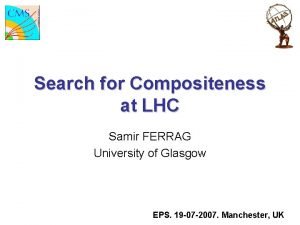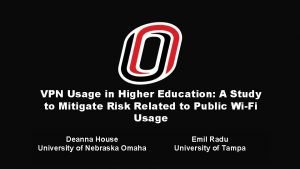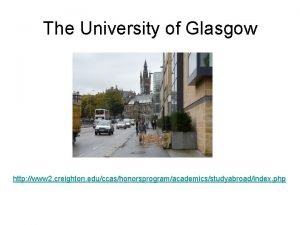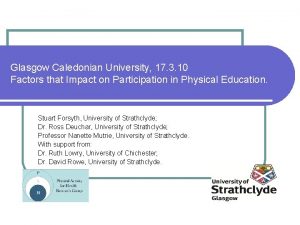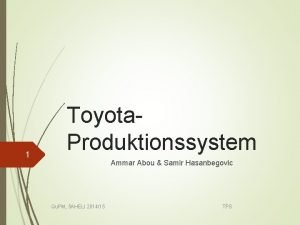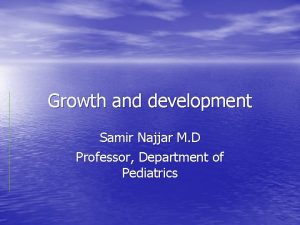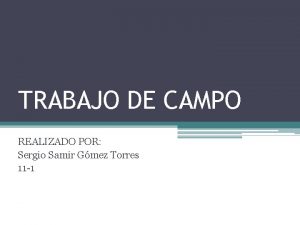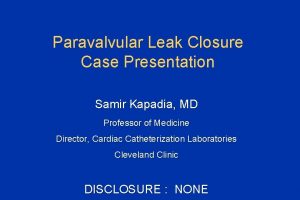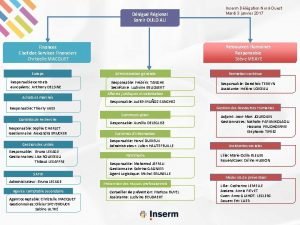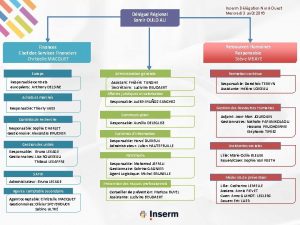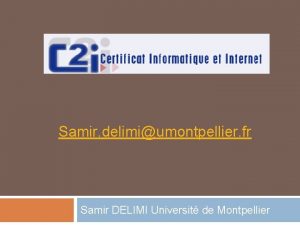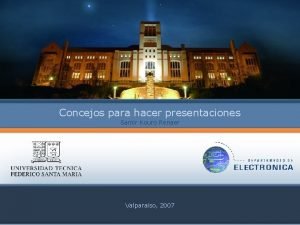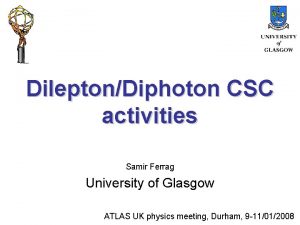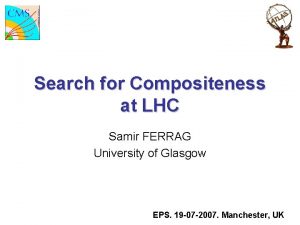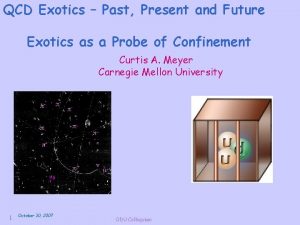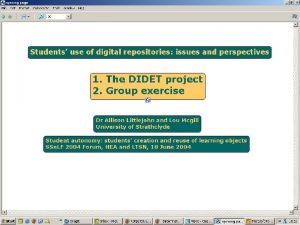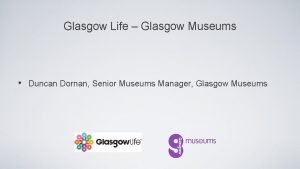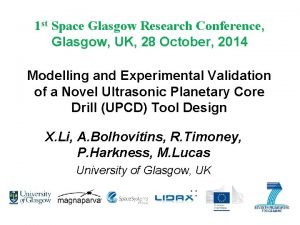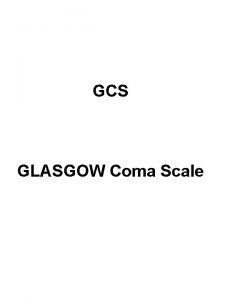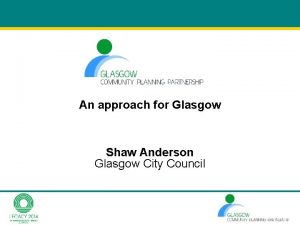Is it Exotics Samir FERRAG University of Glasgow























- Slides: 23

Is it Exotics? Samir FERRAG University of Glasgow ATLAS S. Ferrag UK Physics Meeting

Hinchliffe’s Theorem When a title is in the form of a question, the answer is always: “No” S. Ferrag

Outline • Motivation • Summary of ATLAS Exotic activities • Fake discoveries: – Theoretical uncertainties from the Standard Model – Experimentation • Natural strategies (careful approach) • Conclusion S. Ferrag

Introduction: Exotics is not a whim… • Why 3 generations? – Larger symmetry group, compositeness, lepton flavour violation • Why left-handed weak interaction ? – Left-Right Symmetric model • Why all these parameters – Compositeness… • What about gravity, cosmological constraints – SUSY, Extra-dimensions… • EWSB: no Higgs found (yet) ? – Strong symmetry breaking, Little Higgs… I want my discovery ! • Hierarchy of scales – Instability in the EW calculations. Higgs mass • . . . S. Ferrag …but it requires a carefull approach

Non SUSY BSM • Ingredients for BSM physics: – Space time + Geometry + Fundamental fields & Gauge Symmetry + Symmetry Breaking • Space-Time: – Extra dimensions? : another fundamental Mp scale • • • Factorized and non-factorized Large, Small, Universal or no Consequences of low Mp: Black Holes • Larger Gauge symmetries: – New gauge bosons and new heavy fermions – Flavour violation • Fundamental Fields: – Standard Fermions and Bosons or Compositeness • new fundamental particles, larger symmetries. . . • Symmetry breaking: excluding SUSY – Dynamical Breaking: Vector Boson interactions, non Higgs mechanism S. Ferrag

Classification by topics and models • Extended gauge symmetries: Heavy Gauge bosons: Z’, W’ LRSM: H++, Z’, W’, Majorana N… Heavy fermions Isosinglet quarks (E 6 down, Top) Flavor Changing Neutral Current (FCNC) Compositeness: Excited fermions (electrons, quarks) Leptoquarks • Extra dimensions Large extra dimensions: direct Graviton production, Virtual exchange of Gravitons Black Holes Small extra dimensions: KK excitations of gauge bosons: W, Z and g Universal extra dimensions Coupling unification Warped extra dimensions: RS Radion, Narrow Graviton resonance • Dynamical S. Ferrag symmetry breaking: Little Higgs, Technicolor Vector Boson scattering: WW, WZ

Outsider’s a priories…(sometimes real!) • Two Exotic behaves in Exotics: – Study the phenomenology of models which are sufficiently new, bizarre, or baroque that nobody had looked at them yet: • “Collider signals of neutrino-mediated SUSY with breaking of Rparity, T-parity, G-parity, P-parity, CPT, Lorentz invariance and Unitarity” – Study increasingly obscure phenomenological details of well developed models, preferably those which will only be accessible to colliders or collider upgrades that will never happen. J. Lykken @ les Houches 2005 • Follow a healthy strategy for Exotics. S. Ferrag

Experience from the past • Exotic physics has always been the first physics to be discovered… …and the only one never discovered ? • Is our approach a healthy one to Exotics ? • May be, the common sens is to: – first, discover ATLAS/LHC: • Machine backgrounds, Min Bias, Energy scale at high energies, Calibration, Trigger, alignment, Cal linearity… – second, discover Standard Model: • Electroweak physics, PDF uncertainties… – third, discover new physics: it has to be there • May be the corresponding model exists, may be not… S. Ferrag

Why are we going to discover ”Exotics” the first year of data taking and how the discovery will be delayed for later (never)? S. Ferrag

When the Standard Model is not certain… CTEQ hep-ph/0303013 • Excess interpreted as new physics in early days • Today, Tevatron jet data are considered to lie within PDF uncertainties. • The high-x gluon uncertainties has increased by including the high Et data S. Ferrag

…and when Joey says: “I’m not sure!” Mc= 2 Te. V SM Mc= 4 Te. V PDF uncertainties 2 XD 4 XD 6 XD S. Ferrag • Without PDF uncertainties, XD predictions are well separated from the SM ones • With PDF uncertainties Standard Model prediction become band • By increasing Mc, some of the XD predictions fall into the SM band • Predictions of XD model are absorbed in the SM zone by new PDF fit Discovery power is cancelled by PDF uncertainties above Mc=4 Te. V But: are we sure about these uncertainties ? S. Ferrag

But “uncertainty estimations” is not an exact science ! S. Ferrag & A. Djouadi Disagreement at more then 3 sigma between Alekhin and MRST/CTEQ at low Higgs masses low x anti-quarks… S. Ferrag

ATLAS: Another source of new physics… Boundary effect with a Toy MC + • Exponentially decreasing cross section example: jet cross section • Bin transfer: Gaussian + flat tail @ 0, 0. 25, 0. 75 and 1% • Correction: Gaussian only Cross section Resolution • We can make an artificial excess if we don’t handle our apparatus • …Strange resemblance with the Tevatron excess !!! • Are we sure to have enough manpower to understand our detector at high energy? S. Ferrag

And many other examples of discoveries… • Leptoquarks @ HERA (~1996) • First discovery of the top quark @ 40 Ge. V Even the Standard Model can be (re)discovered… • …. • We would like strategies where we minimise such waist of energy, manpower…and faith ! S. Ferrag

Here, we can do “nothing” Version: “n” of the LHC schedule (without uncertainties) • LHC start-up will be slow and gradual • The discoveries announced in 2009 -2010 will be made from Data sets with L<5 fb-1 and not the 30 -300 fb-1 that you see in all the studies (constraints!) S. Ferrag Non-demanding studies are Suitable

Simple final state topologies • Strategy: – Understand the SM predictions and establish their uncertainty band Responsibility in uncertainty calculations Mature experimental tools – Every prediction outside this band is a signature of new physics • Choice of 1 st years @ LHC: – Simple topologies and robust analyses: • Di-leptons, di-photons, dijets…over large energy range S. Ferrag

2 parts: Limits of the SM & possible BSM signatures SM uncertainty zone Non SM measurement mll But: • Even for the simplest topologies (dileptons, diphotons…), Nobody tried to estimate the total theoretical uncertainties (PDFs, m. Ren, m. Fac, higher orders QCD, EW… ) • In ATLAS: most of the tools are tuned for low energy physics S. Ferrag

Responsibility game: Standard Model predictions • Question: What is the SM prediction on the simple topology ? what will we measure at ATLAS when we in this topology ? • Theoretical side: – – • simple final state topology (2 e, 2 g, 2 jets…) observables (may be by interacting with BSM) list and estimate all the uncertainties (PDF, (N)NLO, mfact, mrenor…) GOAL: Make the SM uncertainty band Experimental side: – Experimental considerations: (Reconstruction efficiencies, Machine backgrounds, Min Bias, Energy scale at high energies, Calibration, Trigger, alignment, Cal linearity…) – Mis-Identification: ZZ or WW like DY…(composition of the measured sample with given set of cut) Establish the shape and the composition of measured sample and its uncertainty band S. Ferrag

Exotics: which underlying model ? • For a chosen simple topology @ high energy: – Report of all the existing models in the market – Other observables to disentangle the models and make priority between them • For the first years data: since no excess – Only limits on these models will be measured S. Ferrag

Exotics CSC activities https: //twiki. cern. ch/twiki/bin/view/Atlas/CSCExotics. Analyses • Reclassifying by final state topologies • Diletons, Diphotons and lepton+photon Z’ (several models), RS Graviton, Virtual ADD Graviton Virtual Leptoquarks, Leptogluons, Heavy scalar (Gravi. Scalar, Radion, Heavy Higgs…), Excited Leptons… • Dileptons + jets Majorana Neutrino, Leptoquarks… • Lepton + missing Et W’ • Boson: WW and WZ final state • Multi-Everything: Black Holes S. Ferrag

Dileptons as a simple topology study F. Heinmann Full simulation S. Ferrag

Dibosons final state: WW scattering • The ultimate test of electroweak symmetry breaking – Not unitary above ~1 Te. V if no new physics BG BG signal • Reconstruct hadronic + leptonic W pair • Require forward jets • Veto jets in central region 5 - significance with 30 fb-1 in most difficult case Most difficult case: continuum signal S. Ferrag

Conclusion • We need to understand the Detector and the Standard Model before looking for new physics • Why simple topologies at high energies ? – – – Study programme is luminosity independent Robust analyses first publications (tradition in PP) Nobody estimated the total theoretical uncertainties Nobody look at them in ATLAS Complementary to SM group activities (low energy) • Good candidate to a UK collaboration for the next 5 years. S. Ferrag
 Samir ferrag
Samir ferrag Natural selections exotics
Natural selections exotics Www.menti.com
Www.menti.com Unomaha vpn
Unomaha vpn University of glasgow dorms
University of glasgow dorms University of glasgow pgde
University of glasgow pgde Dr kay munro
Dr kay munro Pgde glasgow caledonian university
Pgde glasgow caledonian university Samir hasanbegovic
Samir hasanbegovic Mohamed samir design
Mohamed samir design Prite review
Prite review Jill is climbing
Jill is climbing Samir khan cranfield
Samir khan cranfield Constitutional growth delay
Constitutional growth delay Samir bhargava
Samir bhargava Mohamed samir design
Mohamed samir design Sergio samir
Sergio samir Samir kapadia, md
Samir kapadia, md Samir saleem
Samir saleem Samir ould ali
Samir ould ali Samir ould ali
Samir ould ali Samir delimi
Samir delimi Samir kouro
Samir kouro Keynesian cross diagram
Keynesian cross diagram
